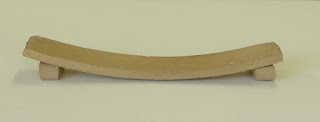Firing at the higher stoneware temperatures produces a less porus ceramic material which is good but the higher temperatures introduces the firing risk of pyro-plasticity. Both stoneware and porcelainous clays can have the same characteristic. As the clay approaches the final vitrification temperature the materials of composition form a homogeneous glass like material, and melt just enough to exclude the spaces which ultimately makes the body less porus. This also results in shrinkage.
The photo below is the result of a test to demonstrate the level of pyro-plasticity of RGH. I made a flat strip of clay about 200 x 30 x 12, dried and bisqued it. After bisque firing it was nice and flat. I then fired it to 1230C in a glaze firing ( it is unglazed) supported at each end by two little props, also of RGH.
As you can see it has slumped as it glassified, until it rested on the shelf. It didn't however get so soft or molten to bond to the props.
There in lies the challenge in higher fired clay forms. Gravity is the threat to stability and forms exposed to deformation under its relentless drag need to be supported. Compounding this impact is the contraction that is occuring, making the object slide over the shelf as it shrinks.
In the commercial ceramics industry the formulation of the clay body is the subject of research to find and formulate one which is less plastic and able to withstand industrial firing process without deformation. Here's an interesting paper to show that it is possible.
http://thaiceramicsociety.com/download/Pyroplasticity_in_porcelain_tile.pdf

No comments:
Post a Comment
Happy to hear your advice, feedback or questions